Hello, fellow lovers of all things green,
Last week, while recording the podcast version of our weekly chat from the screen porch, a loud ruckus of birds erupted, sounding like an argument from the oak tree by the vegetable garden. The ruckus was equivalent to the deafening sounds of crows cawing. How fun to use the nifty Merlin Bird ID app by Cornell Labs to learn they were blue jays (Cyanocitta cristata). Both blue jays and crows are highly intelligent, belonging to the Corvidae family, which also includes ravens and magpies. They are undoubtedly beautiful birds, characterized by their sky-blue coloring and black and white accents.
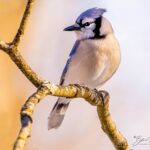
Photo by Blaine Rothauser.
Why I once held a grudge for Blue Jays
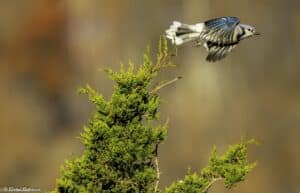
Photo by Blaine Rothauser
For years, I held a grudge against jays for being aggressive, a grudge that originated from being beaked by one while jogging in Cliffside Park, NJ, where I used to live. Three puncture wounds on the scalp cause quite a bit of bleeding. Being a country bumkin, I took it in stride. And giggled, thinking that if someone had gotten a video with my arms flailing to shoo it away, it would surely make it onto America’s Funniest Home Videos.
I washed my hair, doused the wounds with rubbing alcohol, and suited up for my account executive role at a local newspaper. Colleagues were concerned, “Maybe they carry a disease?” Jeez! And so I called the doctor’s office. The desk person’s comeback, “After the doctor stopped laughing, he said You’ll be fine.”
The Fascinating Behavior of Blue Jays
A handful of years ago, while observing a nesting of blue jays near my writing spot, my aversion turned to admiration. Blue jays are masterful copycats of other bird species—one of them, the loud warning call of a red-shouldered hawk, is used to deceive other birds into thinking a predator is present. True, they have a reputation for bullying their way into nests.
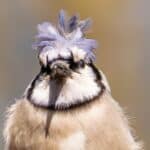
A bad hair day happens to all of us on windy days (Smile). Photo by Blaine Rothauser
Cornell’s site (allaboutbirds.org) redeems the reputation: “In an extensive study of blue jay feeding habits, only 1% of jays had evidence of eggs or birds in their stomachs.” Twenty-two percent of their diet is insects, and the remaining is fruits, grains, and nuts—acorns being their favorite. If you’d like to attract these lovely birds, plant an oak tree. “One of the most important species of the plant kingdom,” writes Douglas Tallamy.
Blue jays gather in flocks in the fall to collect food, and during winter migrations, giving them dominance to defend their sources from other foragers and protect them from predators. These fluid flocks are also called a scold (fitting, given their loud squawks) or party. Much about their migration behavior is unexplained. For example, some blue jays migrate in large flocks, while others don’t, and some migrate one year but not the next. Nature can be mysterious.
“A single jay in a single fall can bury 4,500 acorns.”
I had the privilege of meeting Doug Tallamy in 2021, shortly after the publication of his book, The Nature of Oaks. Not only did he inspire a growing love for our native majestic oaks, but he also inspired a love for blue jays.
“A single oak can make 3 million acorns in a lifetime. And a single jay in a single fall can bury 4,500 acorns — but only recovers 1 in 4. That’s how oaks move around so fast.” Doug said.
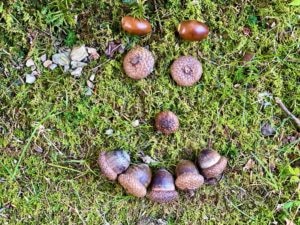
Blue Jays help propagate healthy stands of oaks.
They choose acorns from healthy oaks rather than those affected by Oak Wilt or Oak Decline, thereby helping to propagate healthy stands of oaks. It’s fascinating how they can carry five acorns at a time in their throat, upper esophagus, and beak.
There’s a lesson in the undeserving grudge.
Many folks think of blue jays as aggressive, more than those of us who have gotten beaked (smile). Perhaps their bad reputation stems from their greedy approach to taking over a feeder. But they aren’t the biggest bully at the birdfeeder. Instead, red-headed and red-bellied woodpeckers, common grackles, and squirrels dominate blue jays. And mourning doves, mockingbirds, and sometimes northern robins do too. It’s true; blue jays barge in with their red-shouldered hawk screech to trick the other birds into scattering, but they often quickly return.
There’s a lesson learned about the jay that beaked me long ago, undeserving of a grudge I held for so long. Blue jays are protective and caring towards their families. Isn’t that true of all of us?
Garden Dilemmas? AskMaryStone@gmail.com (and your favorite Podcast App.)
There’s more in the Garden Dilemmas Podcast, including the Acorn Float Test, sure to delight:

Photo by Blaine Rothauser
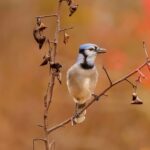
Photo by Blaine Rothauser
About Blaine Rothauser, Natural History Photographer, whose magnificent images you see here, are available to decorate your world.
Related Podcast and Posts:
Native Plants, especially Oaks, are Essential – Blog Post
Ep 35. Leaf Therapy, Essential Oaks
Shagbark Hickories – Nutty Mast Years – Blog Post
Ep 132. Shagbark Hickories and Nutty Mast Years




Blue Jays are a living contradiction; awe-inspiring, annoying, and oddly endearing.
My favorite jay perches in my maple tree, sounding like a mighty hawk before swooping in for peanuts. If I neglect the feeder for a few days, I am loudly scolded for my dereliction of my duties!
Can’t wait for the sun to rise and the jays to visit each morning.
Hi Brian, What a beautiful scene you’ve described, and I adore your descriptive words! “Blue Jays are a living contradiction; awe-inspiring, annoying, and oddly endearing.” They truly are! Thank you for reading and contributing your wisdom to my post, Mary Stone
Hi Mary, We so enjoy your newsletter! There is always something that catches our eye! We too have a reverence for blue Jays! They may scare other birds but they do help warn them against the mighty Coopers Hawks. We both grew up in Cliffside Park NJ it does not seem like a great place to jog! Thanks for the memories! Marlene and Chris Andersen
Hi Marlene, Thankyou for your kind words about my newsletter. I enjoyed jogging around the streets of Cliffside Park for the 13 years I lived there. Especially where you can get the peak of the New York skyline. And of course, “beaking” of the blue jay scene remains one of my life’s most unusual and humorous connections with nature. Smile. Thank you for reading my post! Mary Stone